2018 Hyundai Sonata Plug-in Hybrid light
[x] Cancel search: lightPage 500 of 552

I-6
Interior features .............................................................3-144Clock ........................................................................\
3-149
Clothes Hanger .........................................................3-149
Cup Holder ...............................................................3-146
Floor Mat Anchor(s) .................................................3-150
Luggage Net Holder .................................................3-152
Power Outlet.............................................................3-147
Rear Cutrain .............................................................3-151
Side Curtain ..............................................................3-152
Sunvisor ....................................................................3-14\
7
Wireless Cellular Phone Charging System ..............3-144
Interior overview...............................................................1-4
Jump starting .....................................................................6-4\
Lane Keeping Assist System (LKAS) ............................5-53 Limitations of the System ..........................................5-61
LKAS function change ...............................................5-60
LKAS malfunction .....................................................5-58
LKAS operation .........................................................5-54
LCD Display ...................................................................3-91 LCD display control ...................................................3-91 Light ........................................................................\
......3-104
Exterior Lights..........................................................3-104
Interior Lights ...........................................................3-113
Smart High Beam .....................................................3-106
Welcome System ......................................................3-112
Light bulbs ......................................................................7-\
67 Headlamp, parking lamp, turn signal lamp and side marker light bulb replacement.........................7-68
High mounted stop lamp ............................................7-74
Interior light bulb replacement ...................................7-74
License plate light bulb replacement .........................7-74
Rear combination light bulb replacement ..................7-72
Side repeater lamp replacement .................................7-71
Maintenance services ........................................................7-4 Owner maintenance precautions ..................................7-4
Owner's responsibility ..................................................7-4
Malfunction Indicator .....................................................6-12 Changing a Tire with TPMS ......................................6-13
Mirrors ........................................................................\
....3-19 Inside Rearview Mirror ..............................................3-19
Reverse Parking Aid Function ...................................3-37
Side View Mirrors ......................................................3-34
Index
J
L
M
Page 501 of 552

I-7
Multimedia system............................................................4-2Antenna ........................................................................\
4-2
Audio (Display Audio) / Video / Navigation System (AVN) ........................................4-4
AUX, USB and iPod
®Port ..........................................4-2
Bluetooth®Wireless Technology Hands-Free ..............4-4
Features of your vehicle ...............................................4-7
How vehicle audio works .............................................4-5
Steering Wheel Audio Control .....................................4-3
Owner maintenance ..........................................................7-5 Owner maintenance schedule .......................................7-6
Panorama sunroof ...........................................................3-42 Closing the sunroof ....................................................3-44
Resetting the sunroof..................................................3-45
Sliding the sunroof .....................................................3-43
Sunshade.....................................................................3-4\
3
Tilting the sunroof ......................................................3-44
Parking brake ..................................................................7-24 Checking the parking brake .......................................7-24
PHEV (Plug-in electric vehicle) system ...........................H3 Plug-in Hybrid Vehicle .................................................H3 Recommended lubricants and capacities ..........................8-6
Recommended SAE viscosity number .........................8-7
Refrigerant label ...............................................................8-9
Reporting safety defects..................................................8-11
Safety precautions for hybrid system ..............................H42 High Voltage Battery Air Intake .................................H46
High Voltage Battery System......................................H42
If an accident occurs ...................................................H48
Safety Plug ..................................................................H46
When the hybrid vehicle shuts off ..............................H49
Scheduled maintenance services.......................................7-8 Maintenance under severe usage conditions ..............7-12
Normal maintenance schedule .....................................7-9
Severe driving conditions ...........................................7-13
Seat Belts ........................................................................\
2-24 Additional Seat Belt Safety Precautions ....................2-32
Care of Seat Belts .......................................................2-35
Seat Belt Restraint System .........................................2-26
Seat Belt Safety Precautions ......................................2-24
Seat Belt Warning Light .............................................2-25
I
Index
O
R
S
P
Page 504 of 552
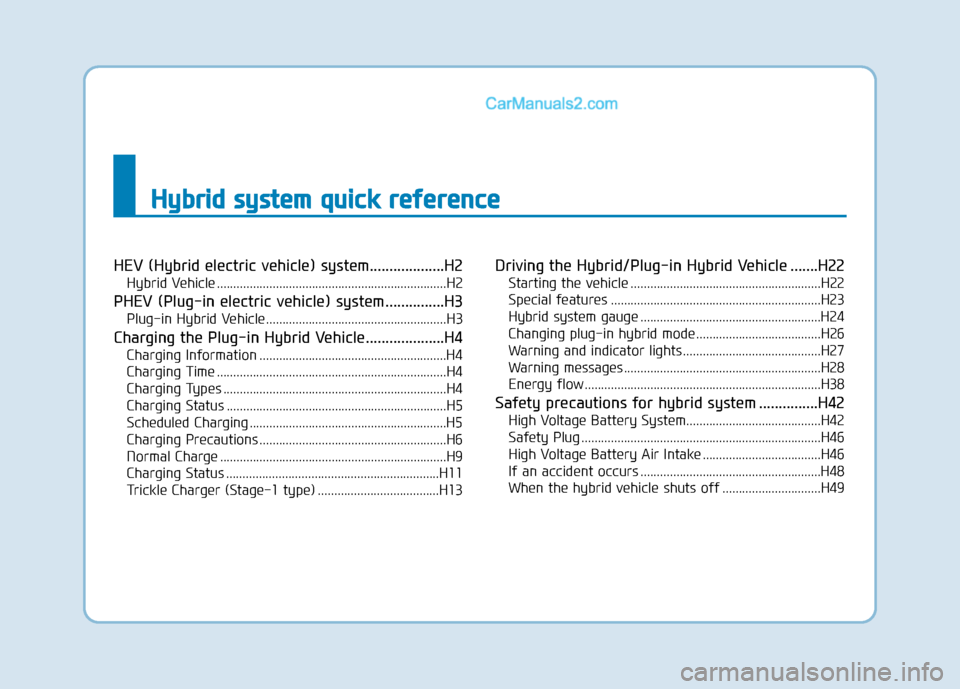
H
Hy
yb
br
ri
id
d
s
s y
y s
st
te
e m
m
q
q u
u i
ic
c k
k
r
r e
e f
fe
e r
re
e n
n c
ce
e
HEV (Hybrid electric vehicle) system...................H2
Hybrid Vehicle ......................................................................H2\
PHEV (Plug-in electric vehicle) system...............H3
Plug-in Hybrid Vehicle.......................................................H3
Charging the Plug-in Hybrid Vehicle....................H4
Charging Information .........................................................H4
Charging Time ......................................................................H4\
Charging Types ....................................................................H4
Charging Status ...................................................................H5
Scheduled Charging ............................................................H5
Charging Precautions .........................................................H6
Normal Charge .....................................................................H9
Charging Status .................................................................H11
Trickle Charger (Stage-1 type) .....................................H13
Driving the Hybrid/Plug-in Hybrid Vehicle .......H22
Starting the vehicle ..........................................................H22
Special features ................................................................H23
Hybrid system gauge .......................................................H24
Changing plug-in hybrid mode ......................................H26
Warning and indicator lights ..........................................H27
Warning messages ............................................................H28
Energy flow ........................................................................\
H38
Safety precautions for hybrid system ...............H42
High Voltage Battery System.........................................H42
Safety Plug ........................................................................\
.H46
High Voltage Battery Air Intake ....................................H46
If an accident occurs .......................................................H48
When the hybrid vehicle shuts off ..............................H49
Page 510 of 552
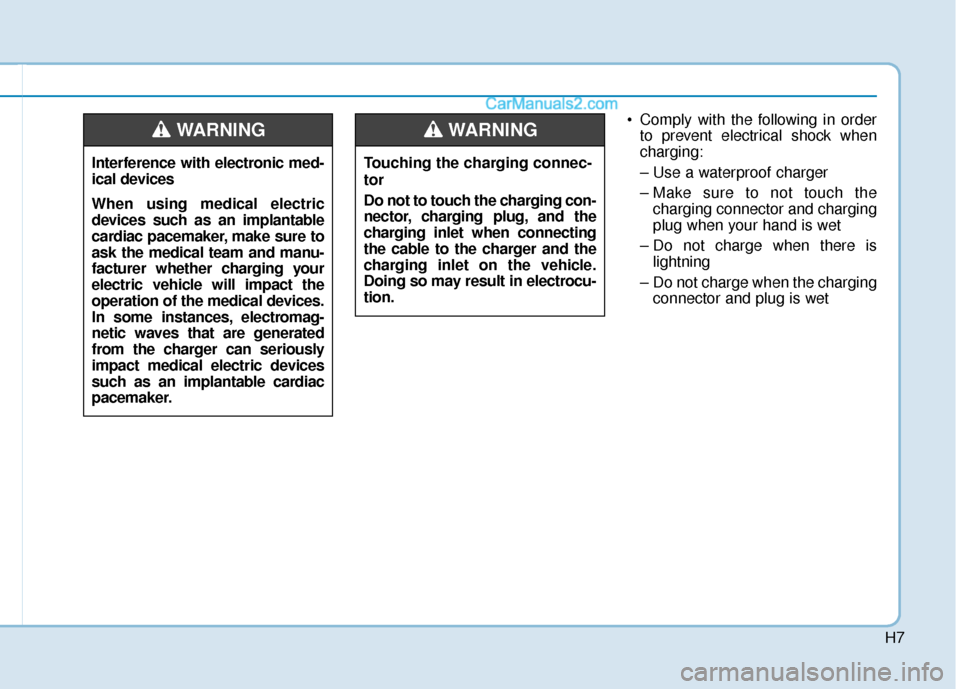
H7
Comply with the following in orderto prevent electrical shock when
charging:
– Use a waterproof charger
– Make sure to not touch thecharging connector and charging
plug when your hand is wet
– Do not charge when there is lightning
– Do not charge when the charging connector and plug is wet
Touching the charging connec-
tor
Do not to touch the charging con-
nector, charging plug, and the
charging inlet when connecting
the cable to the charger and the
charging inlet on the vehicle.
Doing so may result in electrocu-
tion.WARNING
Interference with electronic med-
ical devices
When using medical electric
devices such as an implantable
cardiac pacemaker, make sure to
ask the medical team and manu-
facturer whether charging your
electric vehicle will impact the
operation of the medical devices.
In some instances, electromag-
netic waves that are generated
from the charger can seriously
impact medical electric devices
such as an implantable cardiac
pacemaker.
WARNING
Page 514 of 552
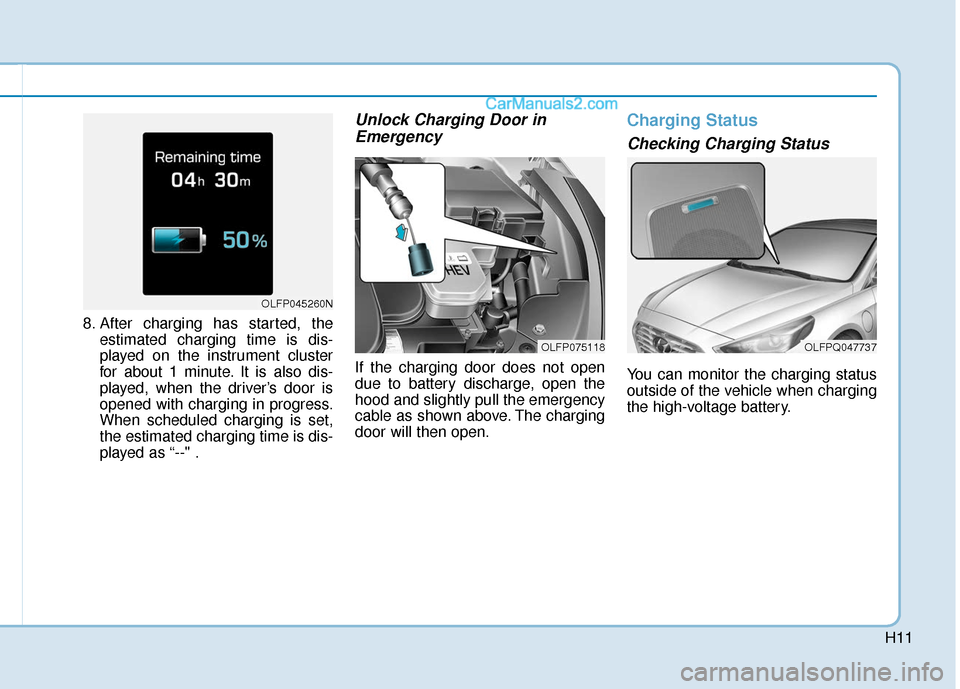
H11
8. After charging has started, theestimated charging time is dis-
played on the instrument cluster
for about 1 minute. It is also dis-
played, when the driver’s door is
opened with charging in progress.
When scheduled charging is set,
the estimated charging time is dis-
played as “--" .
Unlock Charging Door inEmergency
If the charging door does not open
due to battery discharge, open the
hood and slightly pull the emergency
cable as shown above. The charging
door will then open.
Charging Status
Checking Charging Status
You can monitor the charging status
outside of the vehicle when charging
the high-voltage battery.
OLFP075118
OLFP045260N
OLFPQ047737
Page 520 of 552
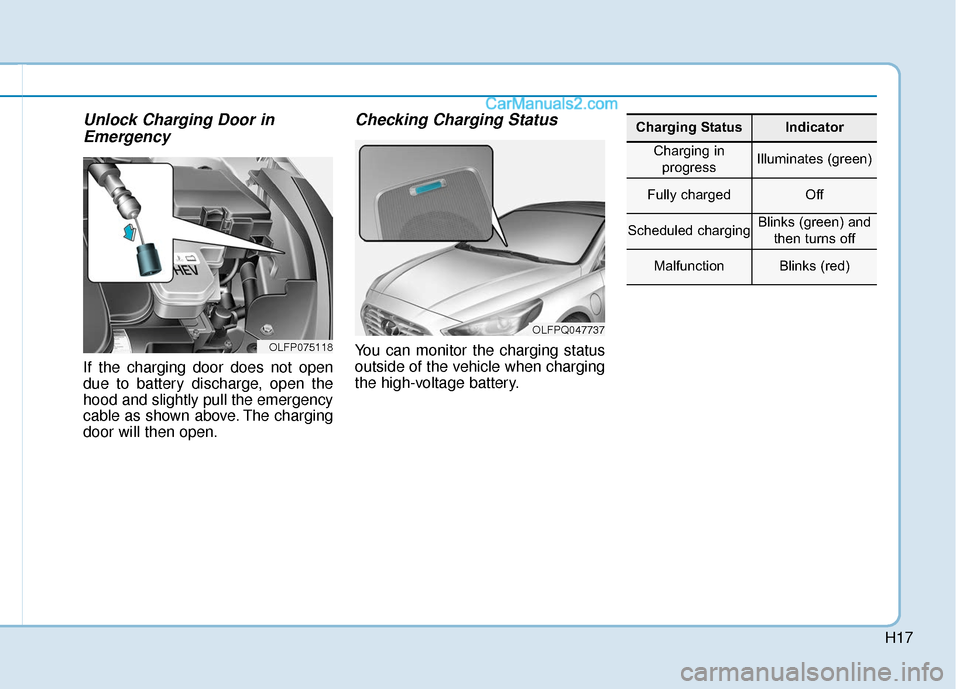
H17
Unlock Charging Door inEmergency
If the charging door does not open
due to battery discharge, open the
hood and slightly pull the emergency
cable as shown above. The charging
door will then open.
Checking Charging Status
You can monitor the charging status
outside of the vehicle when charging
the high-voltage battery.OLFP075118
OLFPQ047737
Charging StatusIndicator
Charging in
progressIlluminates (green)
Fully chargedOff
Scheduled chargingBlinks (green) and then turns off
MalfunctionBlinks (red)
Page 523 of 552
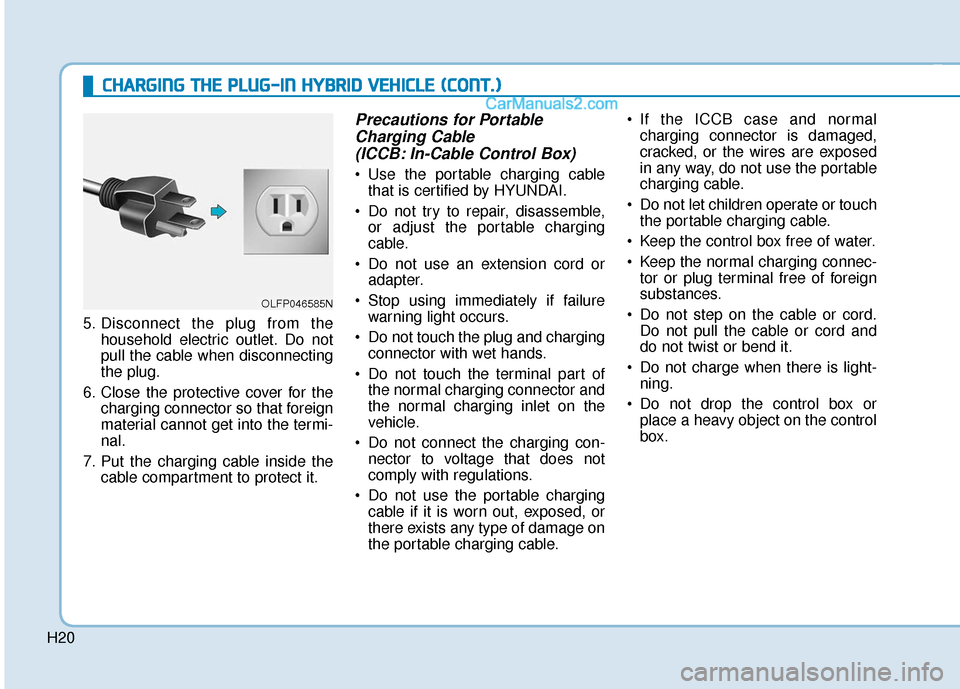
H20
C
CH
H A
AR
RG
G I
IN
N G
G
T
T H
H E
E
P
P L
LU
U G
G-
-I
IN
N
H
H Y
Y B
BR
RI
ID
D
V
V E
EH
H I
IC
C L
LE
E
(
( C
C O
O N
NT
T.
.)
)
5. Disconnect the plug from the
household electric outlet. Do not
pull the cable when disconnecting
the plug.
6. Close the protective cover for the charging connector so that foreign
material cannot get into the termi-
nal.
7. Put the charging cable inside the cable compartment to protect it.
Precautions for PortableCharging Cable(ICCB: In-Cable Control Box)
Use the portable charging cable
that is certified by HYUNDAI.
Do not try to repair, disassemble, or adjust the portable charging
cable.
Do not use an extension cord or adapter.
Stop using immediately if failure warning light occurs.
Do not touch the plug and charging connector with wet hands.
Do not touch the terminal part of the normal charging connector and
the normal charging inlet on the
vehicle.
Do not connect the charging con- nector to voltage that does not
comply with regulations.
Do not use the portable charging cable if it is worn out, exposed, or
there exists any type of damage on
the portable charging cable. If the ICCB case and normal
charging connector is damaged,
cracked, or the wires are exposed
in any way, do not use the portable
charging cable.
Do not let children operate or touch the portable charging cable.
Keep the control box free of water.
Keep the normal charging connec- tor or plug terminal free of foreign
substances.
Do not step on the cable or cord. Do not pull the cable or cord and
do not twist or bend it.
Do not charge when there is light- ning.
Do not drop the control box or place a heavy object on the control
box.
OLFP046585N
Page 525 of 552

H22
D
DR
RI
IV
V I
IN
N G
G
T
T H
H E
E
H
H Y
Y B
BR
RI
ID
D /
/P
P L
LU
U G
G-
-I
IN
N
H
H Y
Y B
BR
RI
ID
D
V
V E
EH
H I
IC
C L
LE
E
Starting the vehicle
1. Carry the smart key or leave it
inside the vehicle.
2. Make sure the parking brake is firmly applied.
3. Place the shift lever in P (Park). With the shift lever in N (Neutral),
you cannot start the vehicle.
4. Depress the brake pedal.
5. Press the Engine Start/Stop but- ton. If the hybrid system starts, the
" " indicator will come on and a
double chime can be heard.
Whether the engine is cold or warm, it should be started without
depressing the accelerator.
After following the start proce-
dures, " " indicator on the
instrument cluster will turn on.
For more information, please
check Chapter 5. ECONOMICAL and SAFE OPERA-
TION of Hybrid system
Drive smoothly. Accelerate at a
moderate rate and maintain a
steady cruising speed. Do not
make "jack-rabbit" starts. Do not
race between stoplights.
Avoid heavy traffic whenever pos-
sible. Always maintain a safe dis-
tance from other vehicles so you
can avoid unnecessary braking.
This also reduces brake wear out.
The regenerative brake generates energy when the vehicle deceler-
ates.
When the hybrid battery power is low, the hybrid system automatical-
ly recharges the hybrid battery.
When the engine is running with the shift lever in N (Neutral), the
hybrid system cannot generate
electricity. The hybrid battery can-
not recharge with the shift lever in N
(Neutral).
Information
In the hybrid system, the engine auto-
matically runs and stops. When the
hybrid system operates, the " "
indicator is illuminated.
In the following situation, the engine
may operate automatically.
- When the engine is ready to run
- When the hybrid battery is beingcharged
- Depending on the temperature con- dition of the hybrid battery
i
To avoid serious injury, turn off
hybrid system and be sure " "
indicator is off before working
under hood. Engine may start
unexpectedly.
WARNING